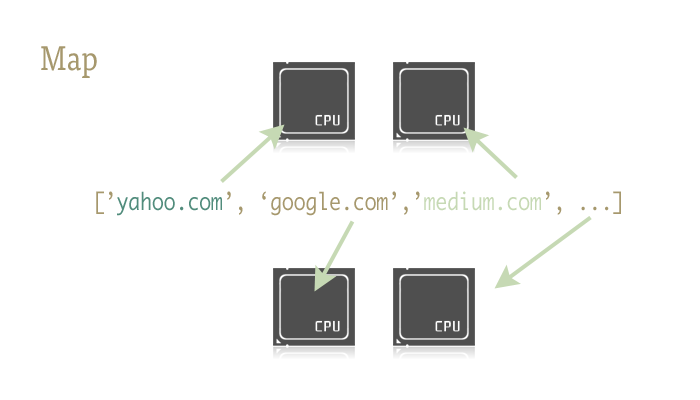转自http://segmentfault.com/a/1190000000414339
map 这一小巧精致的函数是简捷实现 Python 程序并行化的关键。map 源于 Lisp 这类函数式编程语言。它可以通过一个序列实现两个函数之间的映射。
urls = ['http://www.yahoo.com', 'http://www.reddit.com']
results = map(urllib2.urlopen, urls)
上面的这两行代码将 urls 这一序列中的每个元素作为参数传递到 urlopen 方法中,并将所有结果保存到 results 这一列表中。其结果大致相当于:
results = []
for url in urls:
results.append(urllib2.urlopen(url))
map 函数一手包办了序列操作、参数传递和结果保存等一系列的操作。
为什么这很重要呢?这是因为借助正确的库,map 可以轻松实现并行化操作。
在 Python 中有个两个库包含了 map 函数: multiprocessing 和它鲜为人知的子库 multiprocessing.dummy.
这里多扯两句: multiprocessing.dummy? mltiprocessing 库的线程版克隆?这是虾米?即便在 multiprocessing 库的官方文档里关于这一子库也只有一句相关描述。而这句描述译成人话基本就是说:"嘛,有这么个东西,你知道就成."相信我,这个库被严重低估了!
dummy 是 multiprocessing 模块的完整克隆,唯一的不同在于 multiprocessing 作用于进程,而 dummy 模块作用于线程(因此也包括了 Python 所有常见的多线程限制)。
所以替换使用这两个库异常容易。你可以针对 IO 密集型任务和 CPU
密集型任务来选择不同的库。2
动手尝试
使用下面的两行代码来引用包含并行化 map 函数的库:
from multiprocessing import Pool
from multiprocessing.dummy import Pool as ThreadPool
实例化 Pool 对象:
pool = ThreadPool()
这条简单的语句替代了 example2.py 中 build_worker_pool 函数 7 行代码的工作。它生成了一系列的 worker 线程并完成初始化工作、将它们储存在变量中以方便访问。
Pool 对象有一些参数,这里我所需要关注的只是它的第一个参数:processes. 这一参数用于设定线程池中的线程数。其默认值为当前机器 CPU 的核数。
一般来说,执行 CPU 密集型任务时,调用越多的核速度就越快。但是当处理网络密集型任务时,事情有有些难以预计了,通过实验来确定线程池的大小才是明智的。
pool = ThreadPool(4) # Sets the pool size to 4
线程数过多时,切换线程所消耗的时间甚至会超过实际工作时间。对于不同的工作,通过尝试来找到线程池大小的最优值是个不错的主意。
创建好 Pool 对象后,并行化的程序便呼之欲出了。我们来看看改写后的 example2.py
import urllib2
from multiprocessing.dummy import Pool as ThreadPool
urls = [
'http://www.python.org',
'http://www.python.org/about/',
'http://www.onlamp.com/pub/a/python/2003/04/17/metaclasses.html',
'http://www.python.org/doc/',
'http://www.python.org/download/',
'http://www.python.org/getit/',
'http://www.python.org/community/',
'https://wiki.python.org/moin/',
'http://planet.python.org/',
'https://wiki.python.org/moin/LocalUserGroups',
'http://www.python.org/psf/',
'http://docs.python.org/devguide/',
'http://www.python.org/community/awards/'
# etc..
]
# Make the Pool of workers
pool = ThreadPool(4)
# Open the urls in their own threads
# and return the results
results = pool.map(urllib2.urlopen, urls)
#close the pool and wait for the work to finish
pool.close()
pool.join()
实际起作用的代码只有 4 行,其中只有一行是关键的。map 函数轻而易举的取代了前文中超过 40 行的例子。为了更有趣一些,我统计了不同方法、不同线程池大小的耗时情况。
# results = []
# for url in urls:
# result = urllib2.urlopen(url)
# results.append(result)
# # ------- VERSUS ------- #
# # ------- 4 Pool ------- #
# pool = ThreadPool(4)
# results = pool.map(urllib2.urlopen, urls)
# # ------- 8 Pool ------- #
# pool = ThreadPool(8)
# results = pool.map(urllib2.urlopen, urls)
# # ------- 13 Pool ------- #
# pool = ThreadPool(13)
# results = pool.map(urllib2.urlopen, urls)
结果:
# Single thread: 14.4 Seconds
# 4 Pool: 3.1 Seconds
# 8 Pool: 1.4 Seconds
# 13 Pool: 1.3 Seconds
很棒的结果不是吗?这一结果也说明了为什么要通过实验来确定线程池的大小。在我的机器上当线程池大小大于 9 带来的收益就十分有限了。
另一个真实的例子
生成上千张图片的缩略图
这是一个 CPU 密集型的任务,并且十分适合进行并行化。
基础单进程版本
import os
import PIL
from multiprocessing import Pool
from PIL import Image
SIZE = (75,75)
SAVE_DIRECTORY = 'thumbs'
def get_image_paths(folder):
return (os.path.join(folder, f)
for f in os.listdir(folder)
if 'jpeg' in f)
def create_thumbnail(filename):
im = Image.open(filename)
im.thumbnail(SIZE, Image.ANTIALIAS)
base, fname = os.path.split(filename)
save_path = os.path.join(base, SAVE_DIRECTORY, fname)
im.save(save_path)
if __name__ == '__main__':
folder = os.path.abspath(
'11_18_2013_R000_IQM_Big_Sur_Mon__e10d1958e7b766c3e840')
os.mkdir(os.path.join(folder, SAVE_DIRECTORY))
images = get_image_paths(folder)
for image in images:
create_thumbnail(Image)
上边这段代码的主要工作就是将遍历传入的文件夹中的图片文件,一一生成缩略图,并将这些缩略图保存到特定文件夹中。
这我的机器上,用这一程序处理 6000 张图片需要花费 27.9 秒。
如果我们使用 map 函数来代替 for 循环:
import os
import PIL
from multiprocessing import Pool
from PIL import Image
SIZE = (75,75)
SAVE_DIRECTORY = 'thumbs'
def get_image_paths(folder):
return (os.path.join(folder, f)
for f in os.listdir(folder)
if 'jpeg' in f)
def create_thumbnail(filename):
im = Image.open(filename)
im.thumbnail(SIZE, Image.ANTIALIAS)
base, fname = os.path.split(filename)
save_path = os.path.join(base, SAVE_DIRECTORY, fname)
im.save(save_path)
if __name__ == '__main__':
folder = os.path.abspath(
'11_18_2013_R000_IQM_Big_Sur_Mon__e10d1958e7b766c3e840')
os.mkdir(os.path.join(folder, SAVE_DIRECTORY))
images = get_image_paths(folder)
pool = Pool()
pool.map(creat_thumbnail, images)
pool.close()
pool.join()
5.6 秒!
虽然只改动了几行代码,我们却明显提高了程序的执行速度。在生产环境中,我们可以为 CPU 密集型任务和 IO 密集型任务分别选择多进程和多线程库来进一步提高执行速度——这也是解决死锁问题的良方。此外,由于 map 函数并不支持手动线程管理,反而使得相关的 debug 工作也变得异常简单。
到这里,我们就实现了(基本)通过一行 Python 实现并行化。
Update:
译文已获作者 Chris 授权 https://medium.com/building-things-on-the-internet/40e9b2b36148#66bf-f06f781cb52b
-
下面的网址中可以找到关于 GIL(Global Interpretor Lock,全局解释器锁)更多的讨论: http://stackoverflow.com/questions/3044580/multiprocessing-vs-threading-python ↩
-
简言之,IO 密集型任务选择multiprocessing.dummy,CPU 密集型任务选择multiprocessing ↩
